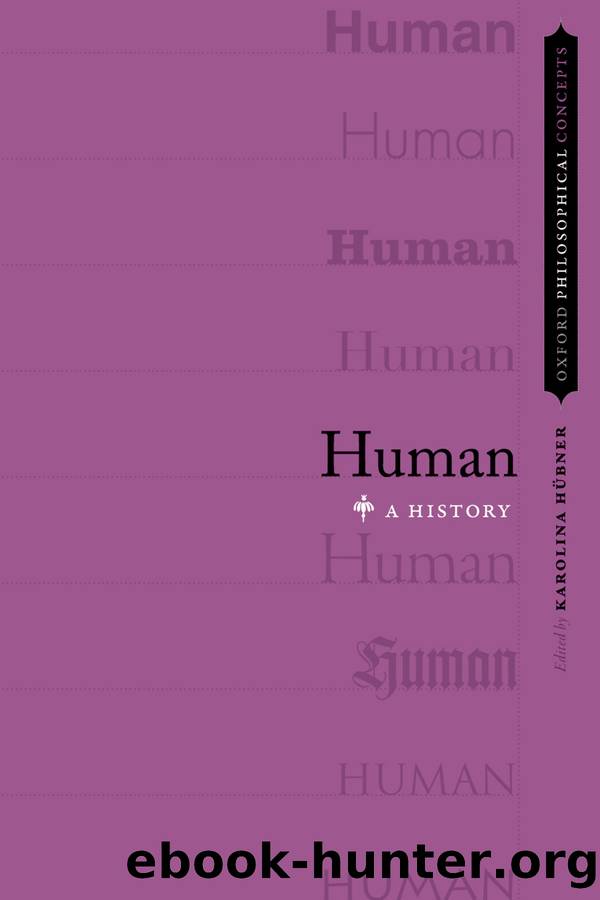Human by Karolina Hubner;

Author:Karolina Hubner;
Language: eng
Format: epub
Publisher: OUP Premium
Published: 2022-06-15T00:00:00+00:00
* * *
1This follows from axiom 1 and proposition 14 of part 1 of the Ethics, henceforth E1a1 and E1p14. Further abbreviations I use are: âappâ for appendix, âcâ for corollary, âdâ for definition, âpraefâ for preface, and âsâ for scholium. Passages from the Spinozaâs works are quoted from The Collected Works of Spinoza, two vols., ed. and trans. Edwin Curley (Princeton, NJ: Princeton University Press, 1985; reprint, 2016), referred to henceforth as C I and C II.
2So E2p10 says: âthe being of substance does not pertain to the essence of man, or substance does not constitute the form of manâ (C I, 454).
3I have argued for this in Ursula Renz, The Explainability of Experience. Realism and Subjectivity in Spinozaâs Theory of the Human Mind (New York: Oxford University Press, 2018), but see also Valtteri Viljanen, Spinozaâs Geometry of Power (Cambridge: Cambridge University Press, 2011), who, however, denies that individual essences are the result of efficient causation. Dominik Perler, âSpinozas Theorie der Universalien,â Zeitschrift für philosophische Forschung 70/2 (2016): 163â88, 185, who, too, identifies individual essences with structural features, remains indifferent with respect to their causation.
4See Dominik Perler, âSpinoza über Tiere,â Archiv für Geschichte der Philosophie 96/2 (2014): 232â61, and Margaret Dauler Wilson, Ideas and Mechanism: Essays on Early Modern Philosophy (Princeton, NJ: Princeton University Press, 1999), 178â95.
5See the passage following E2p13s, C I, 458â62.
6There is no controversy about this, even though some scholars defend the view that the notion of form still plays an important role in Spinoza; see Pierre-François Moreau, âThe Metaphysics of Substance and the Metaphysics of Form,â in Spinoza and the Human Mind: Papers Presented at the Second Jerusalem Conference, ed. Yirmiyahu Yovel, 27â36 (Leiden: Brill 1994), 27â36, and François Zourabichvili, Spinoza und physique de la pensée (Paris: Presses Universitaire de France, 2002), 13â49.
7This has been argued for recently by Michael Thompson; see part 1 of his Life and Action: Elementary Structures of Practice and Practical Thought (Cambridge MA: Harvard University Press, 2008), 25â82. Historically, the second part of Kantâs Critique of the Power of Judgment played a crucial role.
8See, famously, Elisabeth Anscombe, Intention (Oxford: Blackwell, 1957), and for elaboration, part 2 of Thompson, Life and Action, 183â46. The locus classicus is Thomas Aquinas, Summa Theologiae, ed. Peter Caramello (Rome: Marietti, 1952), II, qq. 8â15.
9Not sursprisingly, it is on the basis of this scholium that Yitzhak Melamed has charged Spinoza with maintaining âspeciesism,â i.e. a species-related sort of chauvinism; see his âSpinozaâs Anti-humanism: An Outline,â in The Rationalists: Between Tradition and Innovation, ed. Carlos Fraenkel, Dario Perinetti, and Justin Smith, 147â66 (Dordrecht: Springer, 2011), 163â64. For critical discussion, see Perler, âSpinoza über Tiere,â 248â59.
10For the charge that Spinozaâs metaethics are amoralistic see Melamed, âSpinozaâs Anti-humanism,â 158â61.
11As these terms are all connected in Spinoza, I will use them more or less interchangeably henceforth.
12This is the title to the second part of the Short Treatise as it appears in the register of the chapters which precedes the first part (C I, 60). The title which is given at the beginning of the second book says only âOn Man and What Pertains to Himâ (C I, 93).
Download
This site does not store any files on its server. We only index and link to content provided by other sites. Please contact the content providers to delete copyright contents if any and email us, we'll remove relevant links or contents immediately.
The European History Highway: A Guide to Internet Resources by Dennis A. Trinkle Scott A. Merriman(498)
The Seven Wonders of the Ancient World by Michael Denis Higgins(480)
European Security in a Global Context by Thierry Tardy(472)
European Security without the Soviet Union by Stuart Croft Phil Williams(472)
The Routledge companion to Christian ethics by D. Stephen Long Rebekah L. Miles(461)
Hudud Al-'Alam 'The Regions of the World' - a Persian Geography 372 A.H. (982 AD) by V. V. Minorsky & C. E. Bosworth(402)
Get Real with Storytime by Julie Dietzel-Glair & Marianne Crandall Follis(393)
Gorbachev And His Generals by William C. Green(393)
Tibetan Studies in Comparative Perspective by Chih-yu Shih Yu-Wen Chen(387)
Governance, Growth and Global Leadership by Espen Moe(385)
Hyperculture by Byung-Chul Han(382)
CliffsNotes on Fitzgerald's The Great Gatsby by Kate Maurer(364)
The Oxford History of the World by Fernández-Armesto Felipe;(357)
How Languages Are Learned 5th Edition by Patsy M Lightbown;Nina Spada; & Nina Spada(356)
The Egyptian Economy, 1952-2000 by Khalid Ikram(355)
Oral Poetry and Narratives from Central Arabia: The Poetry of Ad-Dindan : A Bedouin Bard in Southern Najd (Studies in Arabic Literature, Vol 17) (English and Arabic Edition) by P. M. Kupershoek P. Marcel Kurpershoek(345)
The Oxford Handbook of the Incas by Sonia Alconini(336)
Europe Contested by Harold James(323)
The Hutchinson Dictionary of Ancient and Medieval Warfare by Peter Connolly John Gillingham John Lazenby(308)
